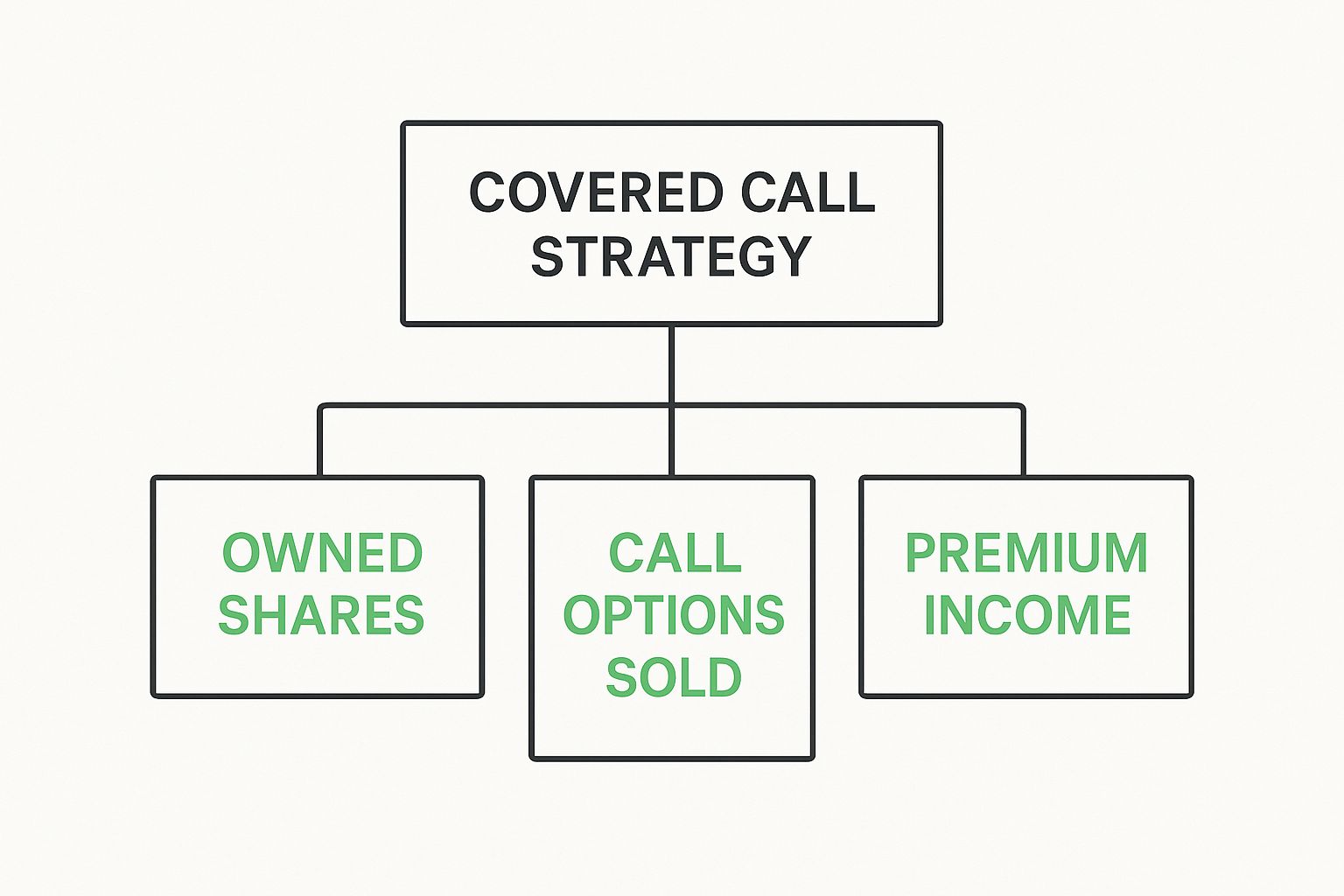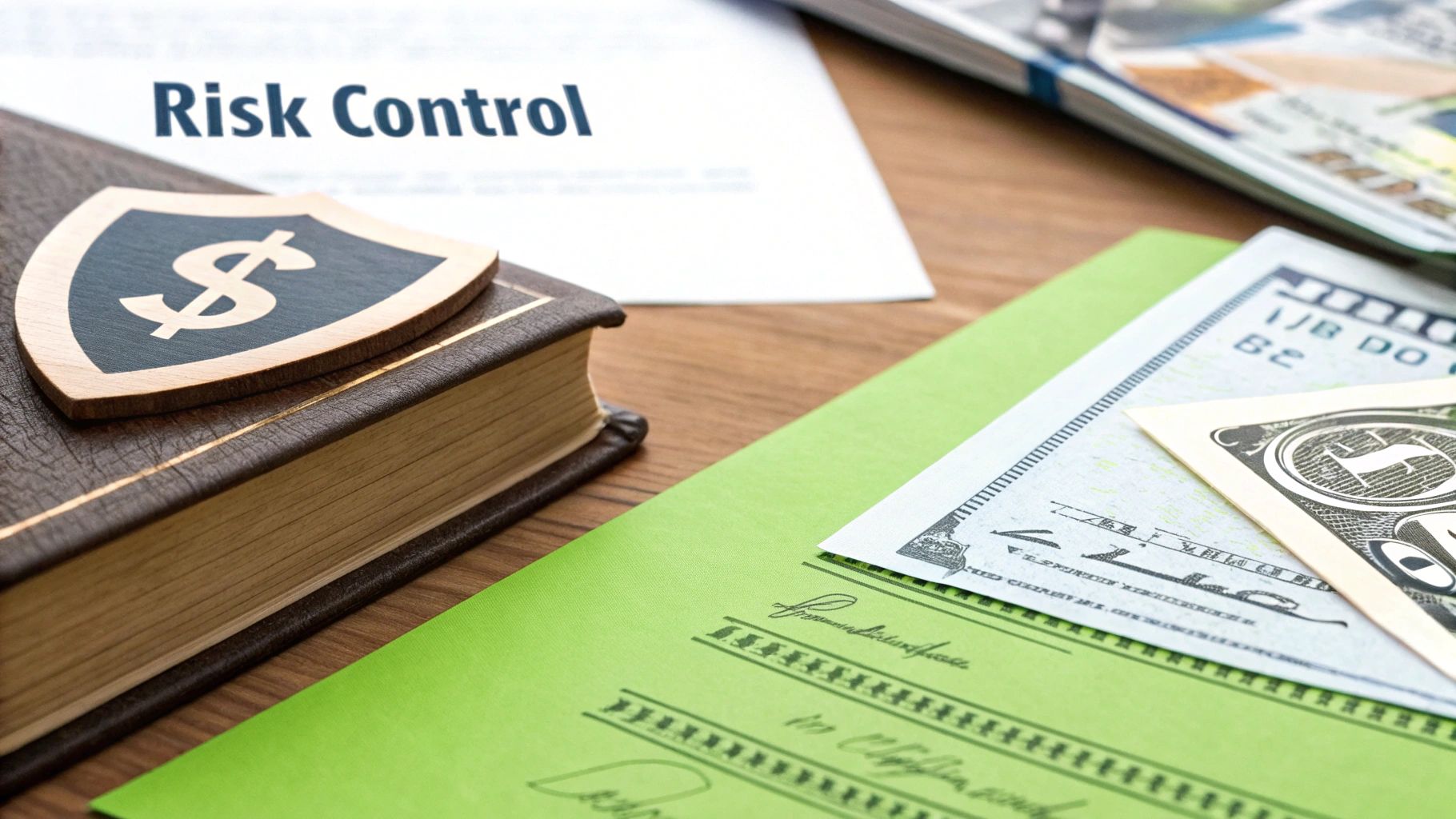When to Sell Covered Calls A Strategic Timing Guide
If a stock moves past your strike, the option can be assigned — meaning you'll have to sell (in a call) or buy (in a put). Knowing the assignment probability ahead of time is key to managing risk.
Posted by
Related reading
A Trader's Guide to Extrinsic Value Option Profits
Unlock the power of the extrinsic value option. Learn what drives it, how to calculate it, and strategies to profit from time decay and volatility.
A Trader's Guide to the Poor Man Covered Call
Discover the poor man covered call, a capital-efficient options strategy for generating income. Learn how to set it up, manage it, and avoid common mistakes.
A Trader's Guide to Shorting a Put Option
Discover the strategy of shorting a put option. Our guide explains the mechanics, risks, and rewards of cash-secured vs. naked puts with clear examples.
The best time to sell a covered call? It’s when you own a stock that’s trading sideways or maybe inching up slowly, and market uncertainty—what we call implied volatility—is high.
Think of it as getting paid a premium for your patience. When other investors are fearful, the 'rent' you can collect for your shares goes up. A lot.
Finding The Sweet Spot For Selling Covered Calls
Deciding when to pull the trigger on a covered call always involves a trade-off. You're swapping the potential for explosive stock growth in exchange for a steady, predictable income stream. This strategy isn't about hitting home runs; it's about hitting singles and doubles, over and over again.
The whole point is to generate cash flow from stocks you already hold, especially when you don't see them rocketing higher in the near future. To do this well, you have to get good at spotting the right market conditions. It's like a farmer planting seeds—you want to do it when the weather is just right. For us, "right" means a neutral to slightly bullish stock paired with high implied volatility.
This infographic breaks down how all the pieces fit together: the shares you own, the call option you sell, and the premium you get paid.

As you can see, selling that call option against your shares is what generates the premium income. It’s a simple, interconnected system.
Ideal vs. Unfavorable Conditions For Selling Covered Calls
Not every market environment is a good fit for selling options. Learning to tell the difference between a great setup and a poor one is absolutely fundamental to your success. If you need a refresher on the mechanics, check out our in-depth guide on how to write covered calls.
To make it even clearer, here’s a simple comparison table that lays out the signals you should be looking for.
| Indicator | Optimal Time to Sell (Favorable) | Suboptimal Time to Sell (Unfavorable) |
|---|---|---|
| Stock Behavior | The stock is trading in a stable, predictable range or has a slight upward trend. | The stock is in a strong, rapid bull run or a steep downtrend. |
| Implied Volatility (IV) | Implied volatility is high, often before an earnings report or during market uncertainty. | Implied volatility is very low, resulting in minimal premium for the risk. |
| Your Outlook | You are neutral to mildly bullish and would be happy to sell your shares at the strike price. | You are extremely bullish and think the stock is about to break out much higher. |
Ultimately, it's about finding that perfect intersection of conditions.
The goal is to collect a fat premium (because of high IV) on a stock you believe will stay below your chosen strike price. This lets you maximize your income while minimizing the chance of missing out on a massive rally.
How the Covered Call Strategy Really Works

Before you can figure out when to sell covered calls, you first need a rock-solid understanding of how the strategy actually works. Forget the complicated financial jargon for a moment. Let's use a simple analogy that makes perfect sense.
Imagine you own a house—this represents your stock. Selling a covered call is a lot like renting out that house for a short period. You get an upfront payment (the "rent"), but in exchange, you agree to a contract that gives the tenant the option to buy your house if it hits a certain price by the end of their lease.
In the world of options, that "rent" is called the premium. It’s your immediate income. The price they can buy the house for is the strike price, and the lease term is the expiration date. That's it. This simple transaction is the heart of the covered call strategy.
The Key Components of the Trade
At its core, a covered call has two non-negotiable parts. First, you have to own at least 100 shares of the underlying stock. Why 100? Because one standard options contract represents exactly 100 shares. Owning the shares is what makes the call "covered"—you've got the asset ready to deliver if the buyer decides to exercise their option.
Second, you sell a call option against those shares. When you do this, you’re creating a contract with two main outcomes for you:
- You get paid cash immediately. This is the premium, and it's yours to keep, no matter what happens next.
- You agree to sell your 100 shares at the strike price, but only if the stock's price is at or above that price when the contract expires.
The core trade-off is clear: you are sacrificing some of your stock's potential upside in exchange for immediate, guaranteed income. Your maximum profit is capped at the strike price plus the premium you received.
Generating Income from Stocks You Already Own
This is a powerful way to make the stocks sitting in your portfolio work for you. Instead of just waiting for a stock to go up, you're actively generating cash flow from it—collecting that "rent" along the way. To get a better sense of this, it can be helpful to compare covered calls to other yield products, such as structured notes, which are also designed for generating consistent returns.
The other side of the coin is your obligation as the seller. If the stock price skyrockets past your strike price, you have to be okay with letting your shares go at that pre-agreed price, even if the open market price is much higher.
This is exactly why knowing when to sell covered calls is so critical. It’s all about balancing that sweet, steady income with the risk of missing out on a huge rally. Grasping this fundamental mechanic is the first step to making smarter timing decisions.
Using Market Signals to Time Your Trades

Mastering the covered call strategy means learning to read the market’s pulse. It’s about finding that sweet spot, the perfect moment to sell. To move beyond theory, we need to look at two key signals that tell you when the time is right. These indicators help you stop guessing and start making data-backed decisions.
The first and most important signal is implied volatility (IV). Think of IV as the market's "fear gauge." When traders are nervous and uncertain, IV spikes. When the market is calm and predictable, IV drops. For a covered call seller, high IV is your best friend.
Why? Because high implied volatility directly inflates option prices. You get paid a much bigger premium for selling your call. It's like getting paid more for the same exact job just because your client is anxious. You aren't taking on any more risk with your underlying shares, but the market is willing to pay you more for the contract.
Understanding Implied Volatility
A great time to look for high IV is in the days leading up to an earnings announcement or during periods of broad market anxiety. You can see this reflected in the VIX (the Cboe Volatility Index). Selling calls during these windows maximizes your income right from the start.
On the flip side, selling when IV is low leads to tiny, disappointing premiums that probably don't justify capping your stock's potential gains. The premium is your compensation for agreeing to sell your shares—make sure you're getting paid what it's worth.
The second signal comes from analyzing the behavior of your specific stock. You’re looking for periods of consolidation or range-bound trading. This is when a stock's price moves sideways, bouncing between a predictable high and a predictable low.
Selling a covered call when your stock is in this state is an ideal setup. You can set your strike price just above that established ceiling, collect a healthy premium, and watch the option expire worthless as the stock fails to break out.
The goal is to identify stocks that are "taking a break." After a strong run-up or a sharp drop, stocks often enter a consolidation phase. This is your window of opportunity.
Aligning Strategy With Stock Behavior
Your goal is to avoid selling calls right before a stock is about to rocket upward. Historical data from benchmark indexes like the Cboe S&P 500 BuyWrite Index (BXM) paints a clear picture. While the strategy can cushion losses in down markets, it significantly lags when the market is roaring.
Between 1986 and 2023, the BXM captured only about 61% of the S&P 500's gains during bull markets. That shows you the real cost of having your shares called away at the wrong time. This trade-off is at the very heart of the covered call strategy.
By combining these two signals—high IV and a consolidating stock—you create a powerful checklist. This systematic approach helps you sell at a time that juices your income while aligning with where your stock is likely to go in the short term.
Figuring out when to sell a covered call is a great start, but it’s only half the equation. The other half comes down to two choices you’ll make every single time you open a trade: picking the right strike price and the best expiration date.
These two decisions are the dials that control your trade. They directly impact how much premium you collect and how likely you are to sell your shares.
Think of it this way: the strike price is like setting the finish line in a race for your stock. It's the price you're agreeing to sell your 100 shares for. Your choice here is all about your goal for this specific trade. Do you want to bank the biggest premium possible, or is keeping your stock the top priority?
Setting Your Strike Price
Your goal for the trade should be your guide. When it comes to strike prices, you’ve got three main paths, each with a clear trade-off.
- Out-of-the-Money (OTM): This strike is above where the stock is trading right now. It gives your stock the most room to run up before you’re on the hook to sell. The trade-off? The premium will be smaller, but your chances of keeping your shares are much higher. This is a solid choice if you're still a bit bullish and want to hang onto the stock.
- At-the-Money (ATM): This strike is set right around the current stock price. It’s the middle ground—you'll collect a healthy premium, but it's a coin flip (roughly 50/50) whether your shares get called away. It's a great balance for generating solid, consistent income.
- In-the-Money (ITM): This strike is below the current stock price. This is where you'll find the highest premiums, but it also makes selling your shares very likely. This path makes the most sense when your primary goal is maximizing immediate cash flow and you're perfectly fine with letting the stock go.
Ultimately, your choice here is a direct reflection of your intent. Are you trying to squeeze every last penny of income from a stock that’s not doing much? Or are you aiming for a small, steady yield while you wait for long-term growth?
Finding the Expiration Sweet Spot
The second piece of the puzzle is your expiration date. This choice is all about working with time decay, also known as Theta. Theta is just a fancy term for the rate an option loses its value as it gets closer to expiring.
And here’s the key: that decay isn't a straight line. It speeds up dramatically in the last 30-45 days of an option's life.
As an option seller, this accelerated decay is your best friend. You want the option you sold to expire worthless, and Theta is the engine that gets you there.
This is why selling options with about 30-45 days left until expiration often hits that perfect sweet spot. It lets you capture the steepest, most profitable part of the time decay curve while still getting a decent premium upfront.
If you sell options too far out, the time decay is painfully slow, and you're locked into a position for longer. On the flip side, super short-term options (like weeklies) might not offer enough premium to make the trade worth your time and risk.
This isn't just theory—the data backs it up. One study looked at covered call strategies on the Russell 2000 index from 2003 to 2018. It found that selling monthly calls about 2% out-of-the-money produced better returns with less volatility than just owning the index. But when they tested the same strategy selling calls with a two-month expiration, the performance edge completely disappeared. It’s a powerful reminder of how critical that one-month window can be.
You can dig into these covered call findings yourself to see just how much timing and expiration can impact your bottom line.
Common Mistakes to Avoid With Covered-Calls

Knowing when to sell a covered call isn't just about making the right moves—it's also about sidestepping the wrong ones. The quickest way to get better is by learning from the common pitfalls that trip up even seasoned investors. It helps you protect your hard-earned capital and build some real trading discipline.
One of the biggest blunders is chasing high yield. It’s incredibly tempting to sell calls on hyper-volatile stocks because they offer fat, juicy premiums. But this is almost always a trap. That high premium is just compensation for extreme risk. A sudden, sharp drop in the stock can easily wipe out an entire year's worth of premium income in a single trade.
Ignoring Fundamentals for High Premiums
Focusing only on the premium while ignoring the health of the underlying stock is a recipe for disaster. A big premium on a fundamentally weak company isn't a great deal; it's a giant red flag. You should only ever sell a call on a stock you'd be happy to own for the long haul.
Don't just take my word for it. A comprehensive analysis looked at this exact problem over a 24-year period. Researchers found that strategies targeting the highest monthly premiums consistently lost money. The capped gains and transaction fees just ate away at any income. The data strongly suggests a more measured approach is the smarter play. You can learn more about these covered call findings and what they mean for your own returns.
Another classic mistake is emotional attachment. It's only human to get attached to a stock that's been a big winner for you, but that emotion can completely sabotage your covered call strategy. If your stock blows past your strike price, you have to be ready to let those shares go.
Refusing to part with the stock—or trying to roll the position over and over to avoid assignment—completely defeats the purpose. The whole point is to generate income and accept the outcome you agreed to when you picked your strike price.
Getting Attached to Your Winners
The best way to fight this is to define your goal before you even place the trade. If your primary objective was income, then having your shares called away at a profit is a win.
Here’s a quick rundown of common missteps and how to fix them:
- Mistake: Selling calls on speculative "meme stocks" for huge premiums.
- What to Do Instead: Stick to stable, blue-chip stocks you're comfortable holding. Sure, the premium is smaller, but the risk to your underlying investment is dramatically lower.
- Mistake: Letting your feelings dictate whether you sell or hold.
- What to Do Instead: Stick to the plan you made when you were thinking clearly. If the stock gets called away, bank the profit and start looking for your next opportunity.
- Mistake: Ignoring the overall market trend.
- What to Do Instead: Think twice before selling calls on your favorite stocks during a roaring bull market. That small premium is rarely worth giving up all that potential upside.
By sidestepping these common errors, you can use the covered call strategy for what it was designed for: a tool for generating consistent, reliable income. If you want more ways to sharpen your edge, check out our guide on 9 proven equity option strategies to boost returns in 2025.
Of course. Here is the rewritten section, formatted to match the provided examples and requirements.
Frequently Asked Questions
Even with the best strategy, you'll run into questions on the fly. Let's tackle some of the most common ones that come up for covered call sellers, with clear answers to help you handle real-world trading situations.
Here are some of the most common questions investors ask about timing and managing their covered call positions.
| Question | Answer |
|---|---|
| What happens if my stock gets called away? | This is the outcome you agree to when you sell a call. If the stock is above your strike at expiration, you sell your 100 shares at that price. The "profit" is the strike price minus what you paid for the shares, plus the premium you pocketed. You get cash, which you can use to buy the stock back (maybe at a dip) or invest somewhere else. |
| Can I sell calls on a stock that pays dividends? | Yes, and it’s a popular move. You own the shares until they're called away, so you collect any dividends paid before then. The risk? If your call is in-the-money and a dividend is coming up, the buyer might exercise early to grab the dividend themselves. Always keep an eye on ex-dividend dates. |
| How do taxes affect my covered call profits? | Taxes are a huge, often-missed, piece of the puzzle. The premium you get is usually a short-term capital gain. If your shares get called away, the tax on that profit depends on how long you held them. |
| What is a 0DTE covered call? | This stands for a "Zero-Days-to-Expiration" covered call. It's an advanced strategy where you sell an option that expires the same day. The goal is to capture extremely fast time decay (Theta). It's a high-frequency game that requires active management. |
Understanding the tax implications is non-negotiable for serious investors. Beyond just the covered call strategy, it's vital to learn how to minimize your tax liability on investment gains to ensure you're keeping as much of your return as possible.
Key Takeaway: Selling a covered call can sometimes change your stock's holding period for tax purposes. It's always a smart move to chat with a tax professional to understand the full picture.
Ready to stop guessing and start making data-driven decisions? Strike Price provides real-time probability metrics for every strike, helping you balance premium income with safety. See how our smart alerts and tailored strategy tools can transform your options selling. Learn more at Strike Price.